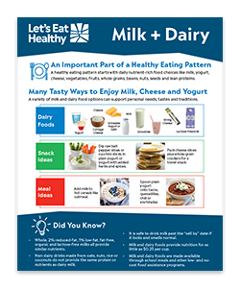Nutrition fuels growth and development from the start.

Eating patterns that include a variety of nutrient-dense foods during pregnancy, infancy and early childhood support brain, bone, lean muscle and immune system development and promote proper growth and healthy weight.
The Healthy Eating TABLE annual publication collects, analyzes and communicates the latest research and data on nutrition education and healthy eating patterns for health and education professionals.
Nutrition Needs Assessment for the First 1000 Days
Through a National Institute of Health grant, researchers at the University of California, Irvine in partnership with Dairy Council of California, conducted a cross-sectional, qualitative project to assess the status and gaps within nutrition education resources and services during the first 1000 days of life.
 Pregnancy: Healthy Moms and Babies Booklet
Pregnancy: Healthy Moms and Babies Booklet
This 8 ½ x 11 8-page booklet provides expectant mothers and breast-feeding women with information on healthy weight gain, physical activity and nutritional needs during this exciting time. Available in English and Spanish in print or digital download.
Healthy Eating for Your Family Booklet
Healthy Eating for Your Family, available in English and Spanish in print or digital download, offers parents practical tips for teaching and modeling healthy eating habits for children at every age to help them learn, play and grow healthfully. Topics include what and how much to feed your child, healthy beverages and snacking tips. It is ideal for one-on-one counseling or as a handout for group instruction.
 Milk and Dairy Foods Tip Sheet
Milk and Dairy Foods Tip Sheet
Milk and dairy foods provide unique nutritional benefits and are an important part of a healthy eating pattern. The Milk + Dairy two-sided tip sheet for families includes meal and snack ideas, cost per serving information, recommended servings sizes and dairy’s health benefits. Available in print or digital download in English and Spanish.
Rethink Your Drink: Make Every Sip Count
Beverage choices do matter. Rethink Your Drink tip sheet educates families how beverages impact health while providing guidance on better beverage choices. Available in print or digital download in English, Spanish, and Vietnamese.
Milk in the CACFP
Handout co-created with the Child and Adult Care Food Program of USDA Food and Nutrition Service, which addresses the value of milk in that program and offers milk-specific tips.
Dietary Guidelines for Americans Professional Resources
The Dietary Guidelines for Americans, 2020-2025 has a variety of resources to make every bite count and build healthy eating patterns for kids under 2.
 Well Nourished Brighter Futures Initiative Webinar Series
Well Nourished Brighter Futures Initiative Webinar Series
Nutrition Education in the 0-5 Childcare Environment
Early childhood is a key time to establish healthy,
sustainable eating patterns that can positively impact a child’s growth and development both in the short-term and later in life. Introducing nutrition education to children at ages 0–5, which is a critical period for physical and emotional
health, can help create healthy habits that positively impact children’s future well-being. Nutrition education aimed at this age group must address their unique nutritional needs and challenges, including inadequate intake of important nutrients
and excess consumption of sugar-sweetened beverages. Consideration must also be given to larger environmental factors including the impacts of food insecurity, malnutrition, obesity, and educational achievement gaps, all of which factor into overall
health and health outcomes.
Healthy Eating During Critical Life Stages
Nutrition science is expanding our understanding of why overall diet quality
is vital to supporting the growth, development and health of people. During a child’s first 1,000 days, or from conception to their second birthday, nutrient-dense foods play a critical role in enhancing specific functions, such as the immune
system, metabolic function and cognitive development. This brief period offers an important opportunity to positively impact the lifelong health and well-being of children. Learn more about how lactation provides as a food pattern model that delivers
food synergy as well as the benefits of focusing on food patterns to improve lifelong health.
Community Collaboration to Improve Healthy Food Access for All
The United Nations considers collaboration a "critical
need” for improving food access. Prior to COVID-19, an estimated 40 million people experienced food insecurity in the U.S., including 12.5 million children. The pandemic exacerbated this problem, forcing communities to find innovative solutions
to provide nourishment to people in need. Access to healthy foods is a problem, and finding a solution to this complex issue will require multisector collaboration and effective leadership from the U.S. government and agencies, schools, hospitals,
nonprofits and the private sector. Join Clancy Harrison, President of the West Side Food Pantry and the founder of Children Feeding Children and FARMU, as she shares ways to engage partners and leaders from various sectors in order to drive changes
and improve the health of people and communities.
Ask a Nutritionist is an educational video series intended to spark dialogue around nutrition. Each episode features a guest registered dietitian nutritionist who uses their expertise, experience and the latest in nutrition science and research to address commonly asked questions and myths related to milk and dairy foods, healthy eating patterns and diet trends, and the importance of consuming a balanced, sustainable diet.
Tune into the following episodes below:
Ask a Nutritionist is an educational video series intended to spark dialogue around nutrition.
Watch hereFind more resources for every education setting to empower lifelong healthy eating habits.